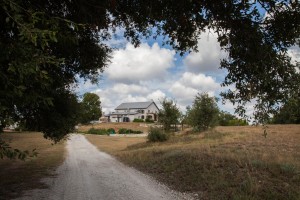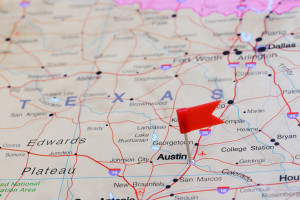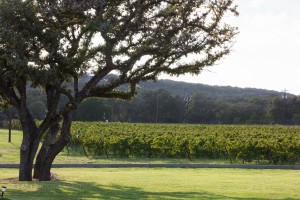This is part two in Elizabeth Miller’s tale of touring and tasting through the Texas Hill Country. For part one, click here.
Rivers and lakes are known to form great wine regions, and for the next visit in our Texas Hill Country tour, we headed out to Lake Travis, just northwest of Austin. Perched on the lake is a parcel of land, an amphitheater like valley with gently sloping land, with a creek running from north of the property and ending in Lake Travis. That creek’s namesake, Flat Creek Estate Winery and Vineyard, calls this area home.
I met with owners Madelyn and Rick Naber who lived in several regions of the US, including California, before setting in Texas. Once in central Texas, they began to notice that the pace of housing development was accelerating drastically, with developers snatching up premier property in the Lake Travis area. In 1998, the Nabers purchased an idyllic 80 acres on the lake, with a commitment to maintain its use as a sustainable agricultural endeavor.
For the Nabers, April fool’s Day in 2000 became a legend (but in this case, it was no joke). On that day, 60 people planted 6,000 vines on 6 acres, thus beginning commercial grape growing at Flat Creek Estate. Later, the endeavor grew to 20 acres of vineyards, a wine production facility, a wine tasting room, and a restaurant. Many of the varieties planted at Duchman—including Sangiovese, Montepulciano and Tempranillo—also thrive at Flat Creek Estate, along with several Portuguese Port varietals.

photo of Flat Creek Estate via: http://www.flatcreekestate.com/flat-creek-photos.html (Peary Photography)
Madelyn and Rick sat down with me to share their wines, popping their 2014 Super Texan. This wine is based on the Italian Super Tuscan concept and features a blend of Italian and non-Italian grapes. At Flat Creek, they start with Texas Hill Plains AVA fruit, blending Sangiovese with Tempranillo and Syrah (although the blends may vary by year). The Nabers shared with me that their 2003 Super Texan was awarded a Double Gold in the San Francisco International Wine Competition, marking the first time a Texas red wine was awarded this prestigious accolade.
Another outstanding wine and indicator of Flat Creek’s full viticultural and winemaking potential is their Port VII. The Flat Creek Estate Port is crafted from traditional Portuguese port wine grapes grown on the estate specifically for this purpose. Each vintage is aged in oak barrels and then added to the Port Solera which includes multiple vintage years spanning 2002 through 2014. Bottled in 2015, the Port VII is rich dark chocolate, blackberry, sweet spices and prunes. What a winemaking undertaking!
The Future of Texas Wine: All of my conversations at Duchman Family Winery and Flat Creek Estate hovered around the current state of Texas wines. What are the challenges? How do they overcome these challenges? What is the fullest potential of Texas?
Even though Texas is one of the top ten wine-producing states in the United States, it is still grappling with an underdog status. Much of this is self-imposed, because when the industry started anew after Prohibition in the 1970s, many producers were pushing for sweeter profiles and easier sells like Merlot, Chardonnay and Cabernet—and in Texas, many of these varieties suffer from climate challenges you’d never find in Napa Valley. Today, Texas winemakers are focusing more on terroir appropriate varieties, and learning how to manage weather challenges that seem to be the norm.
These days, the Texas wine industry is about unlimited possibilities. With 170+ million available acres in a state the size of France, there are so many places to make great wine. The current acreage is likely to explode in coming years.
However, as any Texan will tell you, Texas’ greatest asset is its people. Those who make wine are bold and ambitious in a young industry. Those who promote wine are realizing the fullest potential of Texas wine. As Rick Naber wisely told me, “Until you get sommeliers to wrap their arms around Texas, nothing is going to happen.”
Learn about Texas and other emerging wine regions in Elizabeth’s December 7th SWEbinar: Wednesday, December 7, 7:00 pm central time – Emerging Wine Regions of the US – presented by Elizabeth Miller, CSW, CSS. Who knew that Texas had such a long history of wine production, and that the state grows more Vitis species that any other region on earth? Or that one of Virginia’s oldest wineries is exporting its wine to China. Did you know that Idaho has some of the highest elevation vineyards in the country, or that one of the best domestic Méthode Champenoise wines comes from New Mexico? This webinar covers the lesser known wine producing states, their terroirs, grapes and future growth. Elizabeth Miller is a retailer whose home state of New York is a successful emerging wine region.


So great to hear that in America, great fruit and wonderful wine can be produced in such unexpected areas. A wonderfully written and interesting article.
Looking forward to hearing more at the webinar!
So glad you had a great time on your trip! Texas wine country is magical